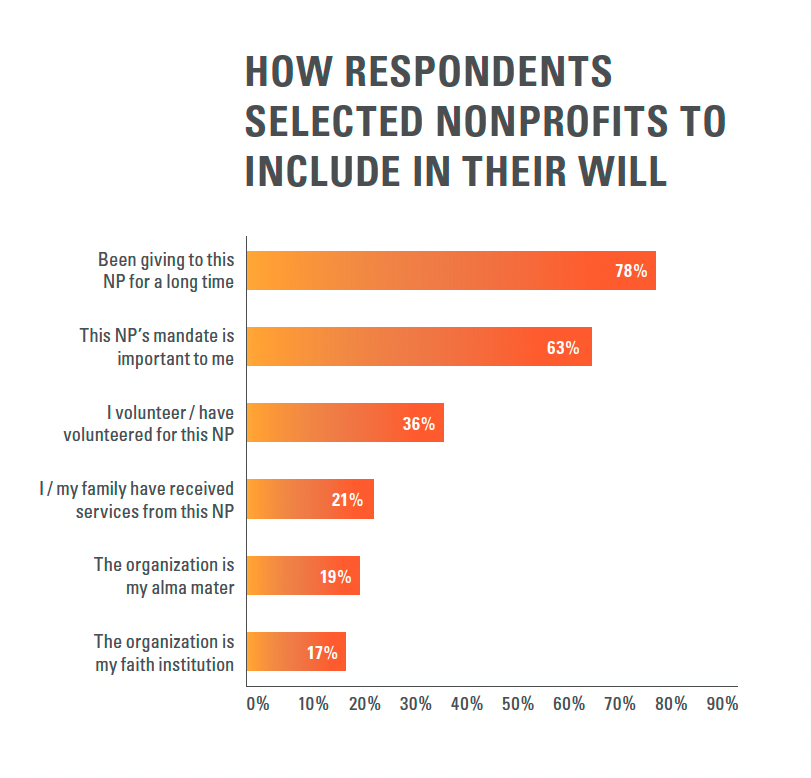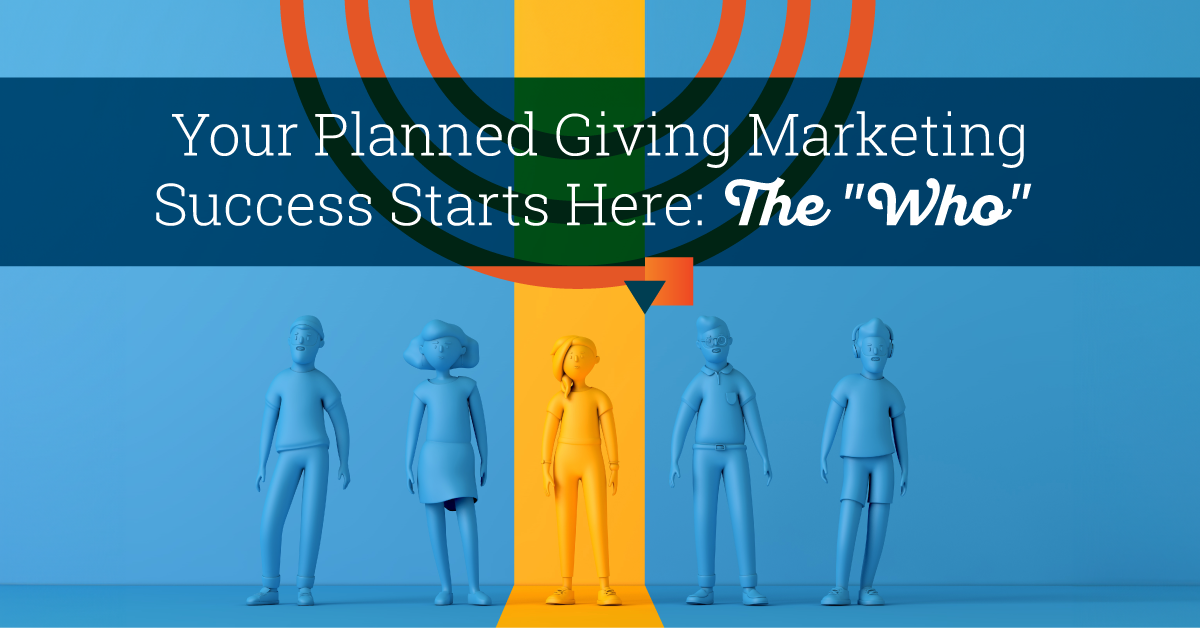
Stelter Strategists, Renee Durnin, CFRE, and Amber Moore join forces to teach you how to identify the best audience for your planned giving campaigns.
If you knew that 40% of the success of your planned giving marketing efforts starts with one simple task, you would do it… right?
I think most of us would.
But when was the last time you examined your donor database and audience selection criteria?
We get it. Days get busy and sometimes organizations feel the need to use a “set it and forget it approach” for their list creation. But by doing so, you could be leaving money on the table.
Over the last four years there has been a surge in philanthropic donations due to crisis giving. And in legacy giving, we are experiencing the “Silver Tsunami” where 10,000 Boomers are turning 65 every day from 2011 till 2030. This increase in donors poses an opportunity for frequent and timely refreshing of audience selection.
Let’s talk about why audience selection is important and discuss a few basic donor demographic data points you can use to make sure your list is off to the right start.
Why Does Audience Selection Matter?
It not only matters—it’s crucial. Targeting the right audience in your marketing efforts contributes to more than 40% of your success (you’ve likely heard of the 40/40/20 Rule of Marketing). The message and how it’s presented won’t matter if you’re not sending it to the right people—audience selection is the linchpin that makes everything work. Some groups may focus so intently on “what” something looks like, forgetting that the creative is responsible for just 20% of the success of your marketing campaigns.
The “who” needs more attention.

Key Data Points for Choosing Your List
Age
Older adults represent a prime demographic for legacy-giving initiatives. As individuals approach retirement age, they often contemplate their legacies and seek ways to support causes dear to their hearts.
But how do you identify this group? Knowing someone’s birth year is key in determining what types of planned giving messages are right for them. Once you know their birth year rather than age, your database can calculate their approximate age at any time. Ages are only a snapshot in time, but birth years are forever.
Using age data can help you save marketing dollars by not sending a CGA message to someone 50 years old or a wills message to a 26-year-old donor.
You can also use this information to refine your direct mail list, if needed, due to budgetary constraints, choose more effective channels for marketing to different age groups (e.g. digital for younger or print for older audiences), and gain insight into your donor’s life stage for one-on-one discussions.
Deceased Flagging
According to the Centers for Disease Control, the rise in US Deaths has DOUBLED from 10 years ago. That increase means you need to clean up your database more frequently, and if you have not performed a deceased append recently, now is the time. Because planned giving messages are often mailed to older populations, there is a high probability your donor information could be outdated.
When creating your target audience, enable deceased flagging from your database to remove anyone who has passed. This saves marketing dollars by ensuring your list contains only living donors. It also helps to improve relationships with donor families who have lost a loved one—rather than coming across as insensitive by continuing to send mail or email to them.
Volunteers, Board, Staff and Legacy Society Members
We know that donors who have a high affinity to your organization make for great planned giving prospects. So make sure that you don’t forget about individuals who have given the gift of their time (not just treasure) when choosing your audience.
For example, consider those who have served as a volunteer, staff member or current/past board member when selecting your audience. Many donors save their largest gift for a legacy gift instead of making donations throughout their lifetime, so it’s important to remember that their gift of time shows their dedication and support of your work just as much as (and maybe more than) a monetary gift does.
We also know that a great prospect for a legacy gift is a donor who has already made one. So be sure you include your current society members in your marketing efforts (with messaging acknowledging they are a legacy member).
How Do I Select the Right Audience?
Once your data starting points are in place, it’s time to take the next step. There are many donor/prospect attributes you could consider when creating your list based on your budget and the planned giving vehicle featured in your marketing piece. But it’s best to begin with the three core elements that target a donor’s readiness for planned giving:
1. Loyalty/Affinity
- Number of years giving or volunteering: 5 to 10+
- Number of lifetime gifts: 5+
- Value of lifetime giving: $500+
2. Age
- Most prolific PG marketing responders: Age 60+
- Broader PG educational messaging: Age 50+
3. Recency of Giving
- Last gift: within 5 years
After taking into account these three aspects, you may still need to adjust your list to meet your budget. Your audience can be narrowed based on donor affinity, whether they are an active volunteer or an alumnus of your organization (see chart below for more examples).

Source: Cygnus Applied Research, Inc.
Tailoring Your Message for Maximum Impact
Audience selection goes hand in hand with message customization. Crafting tailored messages that resonate with your chosen demographic is essential for driving engagement and inspiring action.
In marketing, where you only have 8 seconds to grab the reader’s attention, your legacy marketing should always begin with expressing gratitude for your donor’s past commitment and showing how they are a vital part of your organization. (A key reason your audience selection needs to target loyal supporters!)
This sets the stage for emphasizing the transformative power of legacy giving, highlighting the personal benefits for them and their families, and showcasing the impact their gift can make. Aligning your messaging with the interests and motivations of your target audience is paramount.
By speaking directly to their relationship with you, understanding their life stage, and connecting with their values, your nonprofit can forge deeper connections with your donors and foster greater support for legacy giving initiatives.
Final Thoughts
Legacy giving holds immense potential to secure long-term financial support for your nonprofit and ensure the sustainability of your mission. However, realizing this potential requires a strategic approach to audience selection and an honest look at the data you have.
By targeting specific demographics, tailoring messages, and prioritizing relationship-building, you can unlock the transformative power of legacy giving and secure a brighter future for generations to come. As you navigate the complex landscape of fundraising, remember that the key to success lies in understanding your audience and inspiring them to join you on the journey toward a better world.
If your data could use a little extra hygiene or enhancement help, let us know. We offer services including planned giving prospect identification, date of birth appends, deceased flagging, NCOA and PCOA+ address updates, wealth scoring and more.
And, if you are unfamiliar with the impact of the “Silver Tsunami,” view our webinar, Surviving and Thriving the ‘Silver Tsunami’. Renee Durnin, CFRE, and Laura Spellings, Marketing Sr. Specialist, Gift Planning for World Wildlife Fund (WWF), teach marketing techniques to move your donors along their legacy giving journey and share details of WWFs marketing program that has tripled their results in the last three years.

